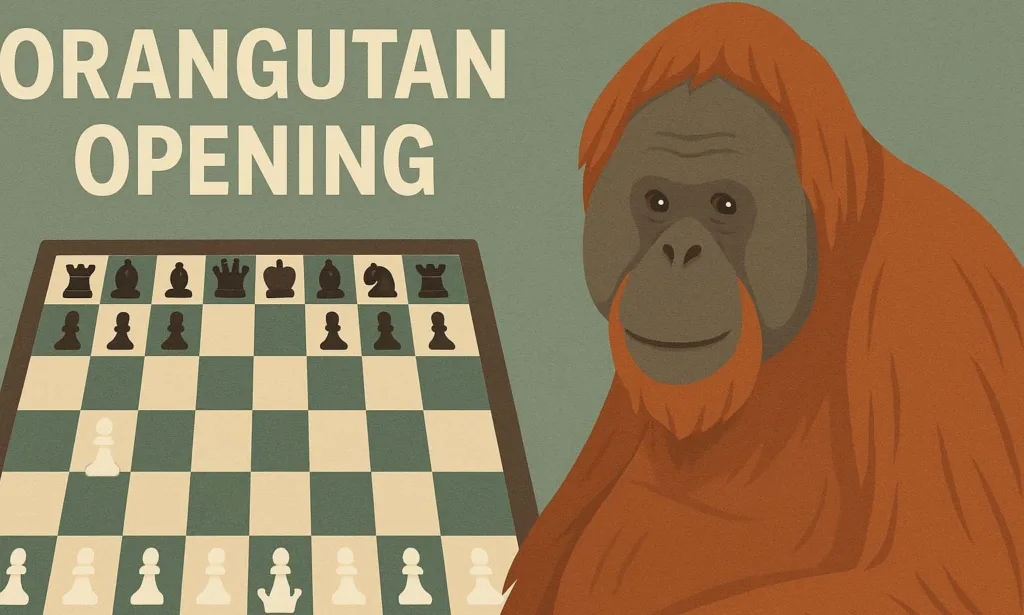Among the many first moves in chess, few are as whimsical, eccentric, and surprisingly rich as 1.b4, a move known by three names: The Sokolsky Opening, The Polish Opening, and—perhaps most famously—The Orangutan. This flank pawn thrust defies conventional opening principles, yet has captured the imagination of grandmasters and chess romantics for more than a century.
Origins: From the Zoo to the Board
The b4 push had its early moments in the late 19th century, such as Bernhard Fleissig’s 1893 game against Carl Schlechter, though early attempts didn’t lead to convincing success. The real spark came from the ever-creative Savielly Tartakower, who not only used the opening to beat Richard Réti in 1919 but gave it its most famous name during the 1924 New York tournament.
As Tartakower tells it, he visited the Bronx Zoo the day before facing Géza Maróczy, where he became fascinated with an orangutan named Susan. The way she climbed the trees reminded him of the climb of the b-pawn, and so, 1.b4 was dubbed The Orangutan. Tartakower used it in the tournament the next day and secured a solid draw against Maróczy.
Though Tartakower’s storytelling flair helped give the opening a name and a myth, its strategic depth was further developed by Alexei Sokolsky, the Soviet master who championed the opening in the mid-20th century and published the monograph Debyut 1 b2–b4 in 1963, giving the opening its other enduring label: the Sokolsky Opening.
Strategic Ideas: A Climb Worth Taking?
At first glance, 1.b4 appears dubious. It neither controls the center directly nor develops a piece. However, it sets in motion a queenside strategy that seeks to undermine Black’s central control laterally. The key follow-up idea is Bb2, which places the dark-squared bishop on the long diagonal where it can pressure e5, g7, and even help in central fights after later pawn breaks like c4 or f4.
Key strategic themes include:
- Queenside Expansion: The pawn on b4 grabs space and may advance to b5, creating long-term pressure on c6 or inducing weaknesses in Black’s queenside structure.
- Diagonal Dominance: The bishop on b2 can become a powerhouse if the center opens or if Black fianchettos their king’s bishop.
- Flexibility: The opening is adaptable. Depending on Black’s setup, White may adopt formations similar to the English Opening, Bird’s Opening, or even transpose into a reversed French.
There is no single “Orangutan style.” For example:
- Alexei Sokolsky was a methodical player who used 1.b4 in solid positional battles.
- Boris Katalymov preferred sharp tactics and creative flank attacks with it.
- Bukhuti Gurgenidze used it to create unusual closed structures.
- Even Magnus Carlsen, known for his pragmatic approach, tried it in rapid games during the 2021 FTX Crypto Cup.
Black’s Most Common Replies
Black has a wide range of replies to challenge White’s flank adventure. The most principled are:
- 1…e5: The most critical test, striking in the center and often aiming to punish White’s delay in central control. A popular line is 1.b4 e5 2.Bb2 Bxb4 3.Bxe5 (see the diagram below).
- 1…d5: Builds a classical pawn center. After 2.Bb2 Qd6, Black pressures the b4 pawn while preparing …e5.
- 1…c6 (Outflank Variation): Preparing …Qb6 or …a5 to chip away at White’s queenside.
- 1…c5 (Birmingham Gambit): A sharp attempt to unbalance the game immediately.
- 1…Nf6: Flexible and developing, but allows White time to expand with b5 or fianchetto.
Even more exotic defenses exist, such as:
- 1…Na6 (Bucker Defense Kingsley Variation)
- 1…Nh6 (Karniewski Variation)
- 1…f5 (Dutch-style counterplay)
Named variations abound. Among the most notable:
- Tartakower Gambit: 1.b4 e5 2.Bb2 f6 3.e4 Bxb4
- Schuhler Gambit: 1.b4 c6 2.Bb2 a5 3.b5 cxb5 4.e4 (see the diagram below).
- Brinckmann Variation: A wild extension of the Tartakower Gambit featuring early pawn sacrifices and central tension.
Theory & Practice
The Orangutan isn’t just a gimmick. Its beauty lies in its unorthodoxy paired with flexibility. It forces Black to think independently from the first move. Many of its structures resemble the English or Bird’s Opening, but the pawn placements are unique. White can adopt:
- An English-style setup with c4 and g3
- A Bird-like structure with f4 and Nf3
- Or even a reversed French if Black plays …e6 and …d5
What the opening lacks in raw central aggression, it makes up for in psychological and positional richness. And for players who prefer to “play chess, not variations,” the Sokolsky is a welcome breath of fresh air. While it’s rare at elite levels due in part to revealing White’s plan before knowing Black’s. It remains a favorite of creative players.
How the Chess Legends View the Orangutan Opening
While the Orangutan Opening might seem like an eccentric sideshow, several of the game’s modern titans have offered it genuine respect. Viswanathan Anand, the former World Champion known for his deep preparation and classical style, once summed it up in a single word: “brilliant.”
Magnus Carlsen, the longest-reigning world number one in history, has played 1.b4 in elite rapid tournaments and casually acknowledged, “Yeah… it’s playable,” – a typical Carlsen understatement that carries weight.
Hikaru Nakamura, one of the most successful blitz and bullet players ever, gave a more detailed nod: “It’s another opening that I’ve played a lot. Magnus also has played it quite a bit. I think it’s completely reasonable… very, very solid, and no reason not to play it.” When legends like Anand, Carlsen, and Nakamura say the jungle trail is safe to explore – you might want to pack your b-pawn and start climbing.
Should You Play It?
To borrow the old American adage: “Don’t try this at home”, unless you’re ready to think for yourself.
The Orangutan Opening isn’t about rote memorization. It rewards understanding, creativity, and a love for the unexplored. Whether you’re a club player seeking offbeat weapons or a grandmaster looking to surprise in rapid formats, 1.b4 may just be the jungle trail you need.
So, next time you’re feeling bold and playful, consider making the climb.
1.b4. Susan the orangutan would approve.
A Repertoire with 1.b4
I. 1…e5 2.Bb2 Bxb4 3.Bxe5 Nf6 4.c3 Ba5 5.Qa4!? Nc6 6.e3 d6 7.Bg3 Qe7 8.Bb5 Bd7 9.Nf3 Bb6 10.d4
II. 1…e5 2.Bb2 Bxb4 3.Bxe5 Nf6 4.c3 Be7 5.g3 Nc6 6.Bxf6 Bxf6 7.Bg2 0–0 8.e3 Na5 9.Ne2 d5 10.0–0 Bf5 11.d4 c6 12.Nd2
III. 1…e5 2.Bb2 f6 3.b5 d5 4.e3 Be6 5.d4 e4 6.c4 c6 7.Nc3 bb4 8.Qb3 Ba5 9.bxc6
IV. 1…e5 2.Bb2 d6 3.c4 f5 4.e3 Nf6 5.Nf3 Be7 6.d4 e4 7.Nfd2 d5 8.b5 c6 9.a4 0-0 10.Qb3
V. 1…Nf6 2.Bb2 g6 3.c4 Bg7 4.Nf3 0-0 5.e3 d6 6. Be2 e5 7.d3 a5 8.b5 Nbd7 9.0-0 Re8 10.Nc3 Nc5 11.Rc1
VI. 1…Nf6 2.Bb2 g6 3.c4 Bg7 4.Nf3 0-0 5.e3 d5 6.cxd5 Nxd5 7.Bxg7 Kxg7 8.Qb3 Qd6 9.a3
VII. 1…Nf6 2.Bb2 g6 3.c4 Bg7 4.Nf3 0-0 5.e3 c6 6.d4 d5 7.a4
VIII. 1…Nf6 2.Bb2 e6 3.b5 b6 4.e3 Bb7 5.Nf3 Be7 6.c4 0-0 7.Be2 d6 (7…d5 8.0-0 c5 9.d3 Nbd7 10.a4) 8.0-0 Nbd7 9.a4 a6 10.Nc3
IX. 1…Nf6 2.Bb2 e6 3.b5 d5 4.e3 c5 5.Nf3 Nbd7 6.c4 Bd6 7.d3 0-0 8.Nbd2 b6 9.Be2 Bb7 10.0-0 Qe7 11.a4
X. 1…Nf6 2.Bb2 e6 3 b5 d5 4.e3 Bd6 5.Nf3 a6 6.a4 0-0 7.c4 axb5 8.axb5 Rxa1 9.Bxa1 Nbd7 10.cxd5 Nxd5 11.Be2
XI. 1…Nf6 2.Bb2 e6 3.b5 c6 4.a4 a6 5.e3 axb5 6.axb5 Rxa1 7.Bxa1 cxb5 8.Bxb5 Qa5 9.Nc3 Bb4 10.Qb1
XII. 1…d5 2.Bb2 Bf5 3.e3 e6 4.Nf3 Nf6 5.c4 c6 6.c5 a5 7.a3
XIII. 1…d5 2.Bb2 Nf6 3.e3 Bg4 4.Nf3 c6 5.c4 e6 6.c5
XIV. 1…d5 2.Bb2 Bg4 3.Nf3 Bxf3 4.gxf3 e6 5.c4 c6 6.e3 Nf6 7.c5
XV. 1…d5 2.Bb2 Qd6 3.a3 e5 4.e3 Be6 5.Nf3 Nd7 6.d4 e4 7.Nfd2 c6 8.c4
XVI. 1…c6 2.Bb2 Qb6 3.a3 a5 4.Nc3 axb4 5.axb4 Rxa1 6.Qxa1 Qxb4 7.Na4 f6 8.Bc3
XVII. 1…c6 2.Bb2 a5 3.b5 cxb5 4.a3 Nc6 5.e4 b4 6.axb4 Nxb4 7.Nf3 Nf6 8.Nc3
XVIII. 1…f5 2.Bb2 Nf6 3.Nf3 e6 4.b5 Be7 5.e3 0-0 6.c4 d6 7.d4
XIX. 1…c5 2.bxc5 e5 3.Ba3 Qa5 4.Nf3 Nc6 5.Bb2 Bxc5 6.e3 d6 7.Be2 Nf6 8.0-0 0-0 9.c4
XX. 1…a5 2.b5
I’m the senior editor of Attacking Chess, a keen chess player, rated above 2300 in chess.com. You can challenge me or asking questions at Chess.com.







1 thought on “The Orangutan Opening: When Real Rebels Start with 1.b4”
Comments are closed.